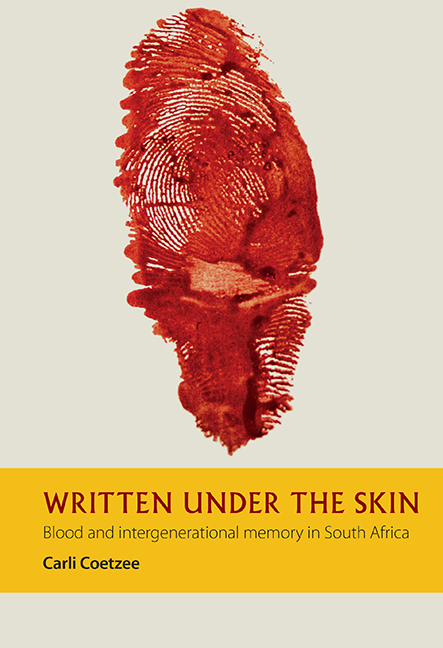Introduction: Piercing the Skin of the Present
Published online by Cambridge University Press: 26 March 2019
Summary
This monograph uses the image of blood just under the skin to theorise and interpret understandings of the ever emergent present in South Africa. Blood just under the skin is a powerful image through which to imagine that which has not yet emerged clearly, but which is already there – like a bruise under the skin, or an undiagnosed symptom in the blood. Blood inside the body's circulatory system contains many secrets and is a rich source of potential information about the state of health or sickness of the body, as well as of its longer histories. Until the skin is pierced, these meanings remain undisclosed. Yet the heaviness of what might be revealed is not lessened. In fact, blood is at its most powerful the moment before the skin is broken and that which is already present in the blood becomes readable.
This moment before the blood becomes visible above the surface of the skin is invasive and potentially dangerous. The blood that becomes readable once it exits the body indexes and has encrypted in it the past, but the argument of this book is intent on the moment when the unbroken layer of skin still holds that blood inside the body. This book is attuned in particular (but not exclusively) to women's embodied experiences of blood, and one of the arguments running through the chapters is that women's experiences of blood are crucial to understanding and ‘reading’ the surging and ever emergent present in South Africa.
In the vast scholarship on blood, kinship relations and coming-of-age narratives dominate. A feature of this literature is the frequent division between men's blood and women's blood. The anthropological debates around blood catalogue and log the bloods of coming-of-age stories in ways that assign and confirm, but also trouble, gender roles. Women's blood has a distinctive literature attached to it, to do with reproductive and menstrual flows (Dahlqvist 2018; Delaney et al. 1988; Knight 1991), as well as the blood sharing and hosting of pregnancy (Rich 1986; Gallop 1988; Martin 1987). In addition, blood has associated with it a literature on secrecy and danger (Starr 1999), generosity and donation (Waldby and Mitchell 2006; Starr 1999; the ‘Body Parts: Transfusion, Tissues, Transplants and the Commodification of the Body’ research project under Catherine Burns's leadership at Wits University) as well as the more obvious associations with violence.
- Type
- Chapter
- Information
- Written under the SkinBlood and Intergenerational Memory in South Africa, pp. 1 - 16Publisher: Boydell & BrewerPrint publication year: 2019



